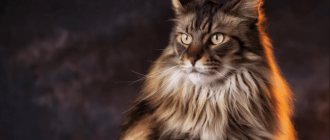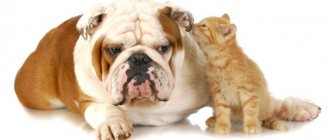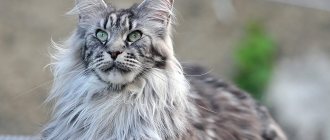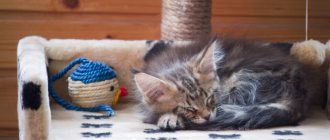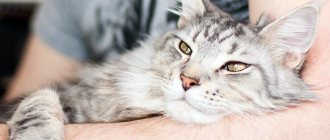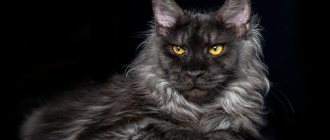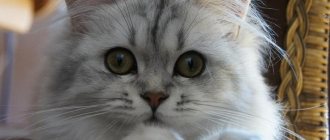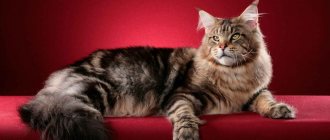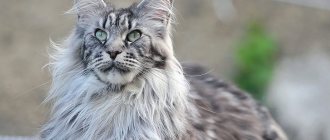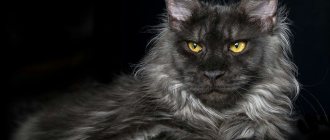Maine Coons differ from other breeds in their unusual appearance and high level of intelligence. They are often compared to raccoons due to their large size and color.
This is how one of the versions about the appearance of this breed appeared. But this is incorrect because raccoons represent a different suborder.
Modern breeders believe that such cats arose as a result of biological processes. There are several versions of how the Maine Coon breed appeared.
Beautiful and powerful Maine Coon breed/Yandex Collections
Legends about the origin of Maine Coons
The history of Maine Coons contains many mysteries and myths. There are romantic options based on external features, and the scientific opinion of zoologists about the origin of these cats. The only thing that has been reliably established is that the geography of origin of the breed is America, Maine.
Marriage between a cat and a raccoon
The myth about the close relationship of these animals tells that cats brought from Asia to the northwest of America crossed with raccoons. To confirm this theory, the color and tail of these animals are compared. These figures are actually similar.
However, from a genetic point of view, such a union is impossible, because The set of chromosomes in these animals is different. This version was liked by the owners of this breed, but is not confirmed by scientists.
Another legend says that Maine Coons were the result of a mating relationship between a cat and an American lynx, because they are large in size and have tufts on their ears. However, according to scientists, animals could not have arisen as a result of such crossed interspecies relationships.
Cat on a ship
One theory about the origin of the Maine Coon is that it was created by crossing American Shorthair cats with Asian Longhair cats brought from Asia Minor on a merchant ship.
There is a beautiful legend about the English captain Kun, nicknamed Raccoon, who took cats with him on his voyages. His favorites were large in size and had long hair. They hunted mice.
Because Maine was a major trading place, ships visited frequently. After each sailor’s trip to America, his pets brought offspring. He loved to give kittens to his friends.
In another version of the story, the captain distributed the over-increased offspring to the residents of the state. Thus, the union of Captain Coon’s cats with local American animals produced the Maine Coon breed, which translated means “Maine raccoon.”
According to another legend, Scandinavian sailors took cats with them on ships to hunt rats. These were large and hardy individuals, accustomed to harsh living conditions. After the ship entered the port, they went ashore along with the sailors and crossed there with aboriginal cats.
One of these stories tells about a cabin boy named Tom Kuhn. When the ship arrived at a Maine port, he sold the kittens born on the ship to a local woman. They became the progenitors of Maine Coons.
Another mythical version says that this breed originated from accidentally surviving animals of the lost continent of Atlantis. One cat ended up in Russia and gave rise to the population of Siberian cats, another in Norway, where the Norwegian variant appeared, and the third was the ancestor of Maine Coons.
Connection with the Queen
They tell the story of how the French Queen Marie Antoinette wanted to escape from the prison in which she was imprisoned by the revolutionaries, and ordered all her wealth to be loaded onto ships sailing to America. Among them were the queen’s favorite cats - large and fluffy.
The queen was unable to escape, but her ships reached the shores of America. Marie Antoinette's pets mixed with local animals, and the Maine Coon breed appeared.
Viking deity
These ancient warriors deified cats, associating them with the goddess Freya. The warlike Scandinavians repeatedly reached the shores of America before Columbus visited there. They took with them on the ship the ancestors of today's Maine Coons, brought from the countries of the East.
Presumably, these were Norwegian cats - large and shaggy, accustomed to difficult living conditions. There is a legend that the animals escaped from the ship and produced offspring by mating with local shorthair cats.
This assumption is confirmed by genetic studies, because Scientists have confirmed the genetic relationship of Maine Coons and the Norwegian wild cat.
However, scientists claim that all the myths about the origin of these animals have no basis in reality and are simply beautiful fairy tales.
Raccoons from Maine
The history of the Maine Coon breed takes us back to the American state of Maine. It is believed that the cats got their unusual name due to their resemblance to raccoons. Indeed, in appearance, Maine Coons are somewhat similar to raccoons - in build, large tail, color. Even the sounds made by young raccoons are somewhat similar to the purring of a cat. That is why the literal translation of the Maine Coon breed from English will mean: Maine raccoon. The first word is a reference to the name of the state (we'll talk about it later), and the second is a residual from raccoon, which is exactly “raccoon”.
Let's talk about the second one right now. The main legend about the history of the Maine Coon breed is as follows: it was born after crossing a female raccoon with a cat. Well, since they are similar, then there is nothing to deny. However, cats of many other breeds also have stripes similar to raccoons. And the Maine Coon cat got its large shape through natural selection. In addition, the impossibility of interspecific crossing has been scientifically proven. So, solely the evolution of the species and neither the raccoon nor the lynx (the tasseled ears of the Maine Coon remind many of this predator) took part in the breeding of this cat breed.
Where did the name come from?
The period of development of the Maine Coon breed remained without substantiated documentary evidence. But it is certain that it was only in Maine that these four-legged domestic hunters first formed a large population and became the predecessors of the modern group. And their similarity with the local species of raccoons only served as the reason for the future common name of the entire breed.
By now, giants have taken pride of place among the three most popular varieties of cats among Americans, and their European branch does not go unnoticed on the Old Continent.
Everything about this memorable giant is attractive - from his kind and sociable character to almost dog-like devotion and desire to serve the owner.
The large size and rich fur of the Maine Coon have served another useful purpose - lovers of fashionable living toys are not very fond of this breed of cat. They take up too much space and during molting they can cover floors, sofas and carpets with a thick layer of hair. But if a good-natured Maine Coon appears in an apartment, then the routine in it immediately changes.
No owner can resist setting aside a couple of hours a day to communicate with this unique cat with the coloring of a raccoon, the tufts on her ears from a predatory lynx, and the character and habits of a dog.
The real history of breeding
The creation of animals that have established characteristics occurs in two ways:
- natural (aboriginal) way;
- man-made, i.e. through artificial crossing and subsequent selection of the best specimens.
Biologists consider the Maine Coon breed to be “aboriginal”, i.e. descended from wild ancestors who lived in Maine, and not artificially bred.
These felines received their qualities as a result of natural selection associated with the harsh climatic conditions of this place.
Gradually, the ancestors of Maine Coons adapted to their environment. Thick long wool covered them from the cold. Long legs made it possible to walk in the snow, and a thick fluffy tail made it possible to sleep on it. The large, furry cats were good hunters of rodents and birds, which they ate.
Rats, mice, etc. damaged the property of farmers who began to domesticate these animals. They lived on a farm and walked in the forest. They did not require much care and did not cause any trouble.
Gradually, Maine Coons became pets and rid the household of pests. Every owner wanted his cat to be better than others. Therefore, the largest cats were selected to produce offspring. So these animals acquired large sizes over time.
Living among people made them friendly and affectionate. After several generations, Maine Coons acquired distinctive features dictated by their living conditions.
This breed was first demonstrated at an exhibition in New York in 1861, and it was officially registered with the felinological organization in 1908. The fame of these animals did not last long - 30 years later Persian cats came into fashion. But American felinologists worked to improve the qualities of Maine Coons.
In 1980, this breed again gained fame on all continents. In America it is still considered the 3rd most common.
Considering the beautiful appearance of these cats, their size and friendliness, they began to be selected. Standard indicators for this breed were established in 1967.
In Europe, the first Maine Coon appeared in France in 1981. A little later, in the mid-80s, this breed was brought to England, where they now occupy 2nd place in the ranking. They appeared in Russia in 1992 and are actively being bred and improved.
Cost of a kitten
A kitten of this breed is quite an expensive pleasure. Prices vary greatly depending on the purpose for which the pet is purchased: for exhibitions, breeding, or, as they say, “for the sofa.”
Kittens that meet the breed standard are usually purchased in order to be bred and shown at various competitions. The cost of such individuals starts from 100 thousand rubles, and this is far from the limit. The price is determined by the breeders themselves, and may vary depending on the region.
Kittens that have any deviations from the standards are cheaper, but also not cheap - about 60 thousand rubles. Such a cat will not be accepted for an exhibition and is not suitable for breeding, but this does not mean that he cannot become a wonderful friend, companion and favorite of the whole family.
Photo gallery of Maine Coons:
1111
Reviews
The description of the breed in reviews of Maine Coons is mentioned most often. Every owner can spend hours admiring their pet. Owners write enthusiastically in reviews about the size of the cats, which impresses everyone they know, about the tufts on the ears, and the fluffy tail. Breeders note the animal's sweet and cheerful disposition. The ease of care makes the breed very easy to keep. Maine Coons very quickly get comfortable in any home and feel like full members of the family. The cute creature, despite its large size, is distinguished by its mobility and will not let its owners get bored. But at the same time, Maine Coons are not prone to mischievous tricks, after which the whole house is upside down. The breed is good in many respects, for which it has earned universal love.
Selection today
Now all over the world, incl. and in Russia, the Maine Coon cat breed ranks first in the ratings. Numerous nurseries are engaged in artificial breeding of cats of this breed and are working to improve the breed through artificial selection and crossing.
Previously, only the black marbled color of the animal was recognized. Now any options are allowed.
European felinologists understand the importance of American roots when breeding Maine Coons, and therefore value cats brought from their historical homeland.
Interest in Maine Coons periodically increased and fell again, because... new breeds appeared. But this species is not giving up its position. Now he is again among the most recognized. These cats participate in international exhibitions of world significance and receive high awards.
Character traits
At first glance, the unrealistically large size, meaningful look and luxurious fur are striking, although this is not all that can attract a person’s attention. People who are the owners of these animals can talk about their pet for quite a long time and surprise the interlocutor.
Cats play like little kittens, with enthusiasm, and during games they look funny and it is impossible to watch them without smiling.
And when the owner is doing some kind of work and is particularly busy with it, his pet will not leave this matter unattended and will definitely go to “help”. The cats will remain nearby throughout the entire activity, or until the work is completed.
When people come to visit, they are afraid at the sight of a large animal and often think that they will be attacked and at least scratched. But all this is in vain, they are very gentle and affectionate, they love peace, and can meet anyone with a perky purr.
The Maine Coon grows from 3 to 5 years, and small kittens are very easy to train.
Earlier it was said that they are hunters and therefore it is advisable to make a tree for them at home to make their well-being more comfortable. It is recommended to calculate such a structure based on the maximum weight of the animal when making it yourself or purchasing it at a pet store.
Its presence in the interior is necessary for sharpening claws, climbing and various games. It is desirable for cats to have an individual space where no one will disturb them. Having matured, Maine Coons do not play with the same passion as little kittens, they are lazier, but, nevertheless, their interest in observing events does not go away.
Sometimes the desire to run and frolic also attacks adult animals, so they need a specially allocated place, taking into account their large size. If you give them a tasty piece to eat, for example, a chicken breast, then they don’t eat it all right away, but after trying a piece, they begin to play with it, pushing it far under the furniture, where possible. During the game, they can perform various virtuoso acrobatic exercises and tricks, and you can watch them throughout the entire show.
These cats amaze with their self-confidence and self-esteem. They do not have the habit of climbing on the table and stealing food, even if they are hungry, they will never even ask for food, because they have a sense of pride from birth.
They find a common language with representatives of other animals, and communication is successful, despite their natural pride. They also respect dogs and do not react to their approach by hissing and ruffling them, like ordinary cats.
But if there are mice or rats at home, then we can assure you with one hundred percent certainty that soon there will be none left, because Maine Coons are excellent hunters.
If the house is filled with flies or midges, then there is no doubt that the cats will catch them all. They can simply look at the birds from the window without making any attempt to catch them. In addition, if a cat was raised with other representatives of small animals, then he is accustomed to them, so they do not need to be afraid of him. Maine Coons are also indifferent to aquarium fish.
And here is another difference from ordinary cats: they never meow, but utter sounds that, due to inexperience, cannot be distinguished from human ones. When cats say something, you can hear the difference in the shades of their voices, so many owners understand what their favorite cat is talking about. And another revealed fact is that they are intellectuals and understand their owners perfectly, they never wake them up in the morning, even if they are very hungry.
No less noticeable is such a character trait as accuracy. For example, if something is spilled on the floor, the cat will definitely go around it so as not to get dirty. They can go to bed in any place, and the positions taken at this time can be unimaginable and masterly, which cannot but cause surprise in any person who sees it.
Many owners of this breed claim that their pet knows much more than the owner how things are in the house. Since Maine Coons are smart and naturally well-mannered, they are distinguished by their intelligence.
There is no need to spend a lot of time for the training process, since the animal understands words perfectly. Many people believe that these cats are smarter than some people.
Care
Caring for cats is labor-intensive. Requires a lot of time and effort. The reward is a happy, beautiful and loving pet.
Check your ears and eyes regularly. If dirt and wax have accumulated in your ears, remove them with a cotton swab soaked in a special lotion.
The cat's eyes should be clear. If there is discharge in them, remove them with a special napkin. If there is none, use a swab moistened with boiled water or eye lotion. It is not recommended to use chamomile infusion. It has a bad effect on the hair around the eyes.
Wool
A kitten must be taught to care for its fur literally from the first days it arrives in the house. If you don't do this, he won't like handling the comb later. He will resist and may show aggression.
Starting from six months, kittens' coats change. The baby's undercoat falls out. The fur becomes thick and tough. To make this period pass faster, the animal must be combed at least twice a week.
In addition, during this period the pet’s body especially needs vitamins and microelements. If there are not enough of them, the period of baby molting will drag on for a long time. The appearance of the coat will deteriorate.
An adult animal sheds twice a year - in spring and autumn. For cats that live in apartments, their schedule is often disrupted. Shedding may occur earlier or later and may take longer.
In addition to seasonal molting, the coat is constantly renewed. Experts say that each hair on a Maine Coon “lives” for about a month and then falls out.
Regular brushing will help maintain the beauty of the coat and prevent the formation of tangles. Makes it easier to maintain cleanliness in the apartment.
If the cat is not brushed, he will lick the fur off himself. As a result, it will accumulate in the intestines, which can lead to health problems.
How to brush a Maine Coon
This must be done in several stages.
First, comb the animal with a wide-toothed comb. This will allow you to identify problem areas.
Most often, hair rolls up behind the ears, on the stomach, chest, lower neck, and hind legs.
Carefully remove any tangles found with your hands. Try combing. If that doesn't work, cut them out with scissors.
After this, comb the coat with a fine-toothed comb. This will remove the undercoat and “outdated” hairs.
Bathing
Maine Coons love water. If babies are introduced to water baths from an early age, they will begin to enjoy the procedure.
You need to bathe your cat in warm water – 35 degrees. Place a rubber mat or towel on the bottom of the bath to prevent your pet from slipping and falling. Make sure that water does not get into your pet's ears.
Maine Coons need to be washed with special shampoos for long-haired cats. Then rinse with water.
Upon completion of the procedure, the animal should be dipped in a soft towel. If you rub too hard, the fur may become tangled.
After the bath, make sure that the cat does not get caught in a draft and catch a cold. To prevent this from happening, dry the fur coat a little with a hairdryer. Then let the cat finish the job himself - lick the fur.
Nail care
Cats themselves monitor the length of their claws. If necessary, grind them off or bite off the ends. However, the owner must keep this process under control.
Maine Coons need to sharpen their claws. To prevent cats from damaging the furniture in the apartment, it is necessary to install special scratching posts. If they are not there, then there is a high probability that upholstered furniture or door jambs will be damaged. Claw grinders must be well secured so that a large cat cannot turn it over or drop it on the floor.
It must be borne in mind that even if a pet uses a scratching post, this does not guarantee that he will put his claws in order on his own. It is necessary to control the length of your pet's claws, otherwise they will cause discomfort and problems for the raccoon cat.
The claws on the front paws are always longer than those on the hind paws.
If the claws are very long and cause discomfort to the pet, they need to be trimmed a little. This can be done at a pet salon, veterinary clinic, or invite a specialist.
The owner can trim the pet's claws himself. However, inexperienced people should not undertake this procedure. The claw contains blood vessels. If they are damaged, severe bleeding will occur.
Particular attention should be paid to the fifth toes on the front paws. These fingers do not come into contact with the ground or floor. Long claws grow on them and begin to bend at the end. Sometimes it grows into the skin. The pet is in severe pain. To prevent this from happening, the claws need to be trimmed on time.
If a cat breaks a claw while playing, its sharp tip must be trimmed. Otherwise, a fragment of the claw will damage the animal's paw. The wound must be treated with an antiseptic.
What to feed
The cat must be fed food prepared especially for it. Food from the owner's table is harmful to the pet. This is due to the characteristics of the animal’s digestive system, which differs from the human one. Food from the owner's table is poorly digested and can cause a number of diseases.
There are two options for feeding the animal:
- natural,
- industrial feed.
You can choose a natural diet for your pet only if you have the time to cook especially for him.
Foods that are good for Maine Coons
- Lean meat: horse meat, beef, lamb, rabbit, turkey, chicken.
- Offal: heart, tripe, liver.
- Vegetables: carrots, pumpkin, zucchini, cauliflower. They can
- Greens: parsley, dill, lettuce.
- Cereals: oatmeal, rice, buckwheat.
- Sea fish: hake, pollock, pink salmon.
- Chicken and quail eggs.
- Fermented milk products: cottage cheese, kefir, yogurt, Varenets.
- Vegetable oil. It should be added to vegetables and cereals 1⁄2 teaspoon. Sunflower, olive, flaxseed are suitable.
Forbidden food
- Fat meat. Causes disruption of the digestive system. Frequent use can lead to the death of the animal.
- Bones. Can injure the gastrointestinal tract.
- Milk. Causes indigestion.
- Beans. Lead to bloating and flatulence.
- Noodles. Buns and pies. Provokes gastrointestinal colic, bloating and diarrhea.
- You should not feed your cat salty food. Because of it, the risk of cardiovascular diseases increases.
An adult Maine Coon should be fed 2 times a day. To do this, the daily food intake should be divided into two meals.
The cat should always have access to a cup of clean water
If you don’t have time to prepare food for your cat, commercial food will help get out of the situation. Choose a product from one of three classes:
- premium;
- super premium;
- holistic.
Depending on the consistency, industrial feeds are divided into 2 types: dry and wet.
Each has its own advantages and disadvantages.
Dry food can remain in a cat's bowl for 24 hours. There is no moisture in it. When using it, your pet must be provided with access to clean and fresh water.
Wet food is available in the form of jellies and pates. It is well absorbed by the cat's body. It is not only nutritious, but also high in calories. Pets love him. If it is abused, the coon may become overweight.
You can combine dry food with wet food. In this case, dry food should account for 75% of the daily ration, respectively wet food - 25%.
Food for a Maine Coon should be selected taking into account age, health status and energy costs. It is important to follow the dosage specified by the manufacturer.
Difficulties and possible illnesses
The breed is hardy and has good health, but cases of illness still sometimes occur. Among the most common diseases is hypertrophic cardiomyopathy.
Spinal muscular atrophy is also among the most common. This disease is hereditary, so the cat’s parents and their health are an important factor when buying a pet. This disease is incurable, it leads to muscle weakness and complete atrophy. Hip dysplasia is also a hereditary disease. It is characterized by severe pain and even lameness of the animal. The disease is not fatal, but it often causes osteoarthritis. To avoid these and other diseases, take your Maine Coon to the veterinarian periodically. He must monitor the health of the animal, then you will not have to worry about the well-being of your pet.
The main rule of keeping a cat is love and respect for him. Before you decide to get yourself a four-legged friend, make sure you are ready to take on this responsibility.
pets2.me
Description of the breed
Animals of this breed are large in size; cats are much larger than cats. The average weight is from 8 to 10 kilograms. There are specimens weighing 12 kg. The body length from the nose to the tip of the tail is about 130 centimeters, with half the size being a luxurious, fluffy tail. The height of the paws is 40-42 cm. However, with such sizes, cats do not look massive and clumsy; they have a large head, a wide chest and a muscular body. These are born hunters.
Maine Coon wool has an interesting property - it is almost impervious to moisture and does not get wet. Moreover, it has different lengths: there is a chic “collar” on the neck, the hind limbs are dressed in “fur pants”, there is thick fur with undercoat on the back, sides and belly, and the head and paws are covered with shorter hair. The shape of the paws resembles snowshoes - they are wide and powerful, with hairs growing between the toes.
This breed has interesting, unique ears - large, located high on the head, with thick skin, covered inside with fur, and outside with dense hair. At the very tips there are tassels, like a lynx. All of these properties helped these cats survive and get food in the harsh places where they came from. The officially recognized homeland of Maine Coons is Maine, United States of America. Farmers specially bred cats to combat rodents that spoiled grain.
It is believed that animals began to be actively domesticated approximately 150-200 years ago. As in any other business, competition and excitement arose between people. Everyone wanted their cat to be bigger than the one on the neighboring farm. Therefore, only the most outstanding individuals were left for the tribe. Thus, the breed was gradually formed. Despite their rather impressive size, cats have a calm, balanced character. They are not aggressive and are trainable. They become attached to their owners and get along well with children.
Appearance
The appearance of the glorious Maine Coon family was significantly influenced by the climate of Maine: it is very difficult to survive in the cold and snowy continental winter without a thick undercoat. A wide paw, protected by additional tufts of fur, is also a useful device that helps to slide along the ice crust without falling into the snow.
Well, its impressive size is an invaluable advantage when hunting small animals. As for modern representatives of the breed, their appearance could not help but be affected by the passion of European breeders for extremism. Today's Maine Coons have significantly increased in size, their faces have become even more elongated, and their ears have grown significantly.
Head
The Maine Coon's muzzle
is massive, noticeably elongated in length, with a relief profile, high cheekbones and a medium-length nose. Since the ancestors of modern Maine Coons hunted rodents, they often had to “dive” into holes for prey, which became the main prerequisite for the formation of a somewhat elongated skull shape.
Eyes
The eyes are round in shape, set wide and slightly oblique. The shade of the iris varies from green to rich yellow and is in harmony with the color of the animal.
Ears
Large in size, with a wide base and a slight forward tilt. A distinctive feature is the “lynx tassels” and “brushes” peeking out from the ear flap. It was the outstanding size of the ear that helped Maine Coons become excellent mousecatchers, for which the breed is especially loved by American farmers.
The skin on the ears is thick, protected by thick hair, and the cartilage structure is dense. To maximize heat retention and protect the hearing organs, coons use an ancient technique: the animal presses its ears tightly to its head, as if folding them, which prevents icy air from penetrating inside the funnel.
Neck
Maine Coon kitten The
neck of Maine Coons is strong, muscular, of medium length, decorated with lush and long hair. Among breeders, individuals with a neck “collar” reaching to the ear flaps are especially valued.
Body
Elongated, close to a rectangle in shape, with well-developed muscle mass. The chest is quite wide, the shape of the back is horizontal.
Limbs
Tall, muscular and very strong. Set wide apart.
Paws
Massive, round in shape, protected by a dense “edge”.
Tail
The Maine Coon's tail is long (equal in size to the length of the body), with a wide base, without kinks. Covered with thick hair, under which a dense, water-repellent undercoat is hidden. In extreme weather conditions, the tail acts as a natural heater: the animal wraps it around the body, thereby protecting itself from the cold.
Wool
The Maine Coon's coat is long (from 10 to 15 cm), but uneven, gradually increasing in volume from the shoulders to the belly. The most luxuriant wool is in the area of the so-called “pants”. In the dorsal area, the cover is more rigid with a predominance of guard hairs. The belly and sides are protected by a soft downy undercoat, the main purpose of which is warming and water-repellent.
Color
A Maine Coon drinks tap water.
Individuals bred in nurseries in different countries can vary quite a lot in both color and size. Recently, cats of any color are allowed to participate in exhibitions, with the exceptions of point, lilac and chocolate. At the same time, the classic “identifying shades” of coons are considered to be agouti, brindle black, marbled black and white (the latter option is widespread in Russia).
Possible defects
If a Maine Coon's appearance does not conform to generally accepted standards, it automatically excludes it from the ranks of the show class. In other words, such individuals are barred from entering exhibitions.
Reasons for “excluding” a cat from participating in all kinds of competitions may be insufficiently fluffy fur in the belly area, too short a tail, small size of the animal, spots and specks on the fur, a relief shape of the nose (the presence of a noticeable depression in the middle), wide-set ears, uniform length of fur throughout the body.
A genetic anomaly such as polydactyly (the presence of an excess number of toes on a cat’s paws) is also considered a significant reason for banning an animal from participating in public events. At one time, this mutation was widespread among Maine Coons, which is why it received the status of the main defect of the breed.
Main features of raccoon cats
Maine Coons develop slowly, only by the age of five do they reach maturity, becoming more than a meter long, and weighing up to 15 (or even more) kilograms (males). These giants are gentle and good-natured, despite their formidable appearance.
They have a slightly elongated head, a slightly curved profile, and high cheekbones. The ears are quite pubescent, and at the tips they are decorated with almost lynx-like tassels.
Coons also have incredibly long mustaches, which helped them, when living in the wild, not to stumble upon bushes or tree branches in the dark.
The body differs in its length. But the Coons have the same long tail - their real pride. For a cat, this is a fairly essential element of survival. It protects the animal from the cold. When he has to lie on the frozen ground, he wraps himself in this shock of six, keeping warm.
Many animals with long fluffy tails do the same. He also plays the role of a “steering wheel” that coordinates Kun’s movements.
The fur of these giant cats is dense and long, which is characteristically water-repellent and protects from external influences.
Kinds
The breed is considered native and one of the oldest in North America. But breeders from Europe created new lines, leaving a recognizable appearance, but assigning new features to the cats. This is how two intrabreed lines appeared - American and European.
- American Coons have a strong and strong bone structure; they are slightly lower than their European relatives, but are not inferior to them in weight and power. Americans have a wide head; the transition from the convex forehead to the muzzle is more noticeable. The eyes are round. The ears are shorter and wider apart than those of Europeans, and lush “lynx” tassels are not adopted. Outwardly, they are more similar to the Norwegian forest or Siberian breed.
- The European type was formed in the 90s of the last century. An important difference is slightly slanted and squinted eyes. It was these individuals who became famous for their slightly predatory and contemptuous gaze due to the unusual shape of their eyes. Their muzzle appears triangular, the body is often elongated, the tail is long, along the back it should reach the shoulder. The paws are high.
Training and communication
Maine Coons are very sociable animals; they love to be in human company. Pets need to be raised from as early an age as possible.
The first thing cats must learn is to use the toilet, as well as a scratching post. This breed is highly trainable; they can easily be taught anything using carrots and sticks. But do not overdo it with the punishment system, otherwise the stress-prone animal will feel bad. For example, you can wean an animal from jumping on a sleeping bed or scratching a sofa using a spray bottle. The water in it should be warm, you need to splash the animal very little: do not allow the fur to be too wet so that water gets into the eyes.
Before punishing an animal for disobedience, think about whether it is to blame for the current situation. Perhaps you yourself did not take care of finding a comfortable place to sleep, or installing a scratching post or tray in an insufficiently secluded place.
Nutrition
Such a large breed of cat eats a lot and often. In nutrition, it is important to choose a direction - either you buy ready-made food of the highest class, or stop at natural products. If you choose the first option, add canned food to dry food 2-3 times a week, and these should be products from the same manufacturer. In the second case, there are also some tips:
- Protein foods that suit him include raw and boiled beef, rabbit and turkey. Pork, duck and goose meat should not be included in the diet, they are too fatty for it. You also need to give up sausages and smoked meats. Sea fish and boiled fish are preferable.
- Include fermented milk products, boiled yolks and quail eggs in your diet.
- The need for fiber is satisfied by selecting cereal porridges.
- Vitamins and minerals are added separately, as well as in the form of sprouted grains. General rules for all types of feeding: be sure to monitor the presence of water in the bowl, do not forget to give a special paste for removing hair from the stomach and buy a glass or metal bowl, plastic may cause be irritating to the skin.
